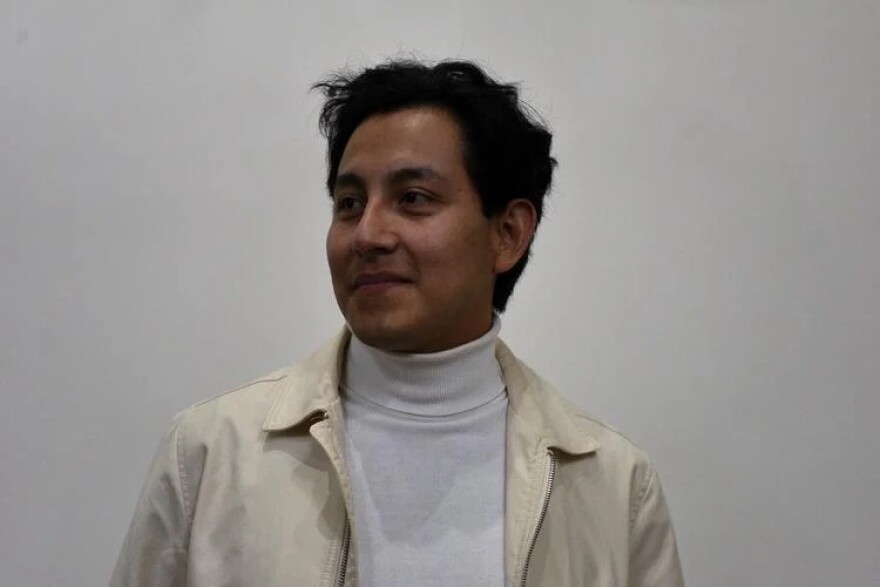Amid the various carols and lights that shone on the streets of Columbia for December’s first Friday, there was a special type of joy inside Stop-gap projects. They were celebrating the debut of their newest exhibition, “La Onda,” which traveled all the way from Kansas City.
This exhibition was curated by Cesar Lopez and Kiki Serna, both Kansas City artists. Lopez attended the debut and greeted guests with a smile on his face. He said that “La Onda” is more than just a gallery, it’s a way to explore and discover what “Latinidad” means within the regions it is displayed.

“It's a conversation that we have with every group of people,” Lopez said. “Every show has been different, every show has included new work every time.”
While Lopez presented some of his work, the gallery highlighted two Columbia artists who had the chance to present their own interpretations on what Latinidad means to them
One of the artists Marina Cano is a Master of Fine Arts (MFA) candidate in fibers at the University of Missouri. She used a digital loom to create two woven pieces. The first is a woven textile with her figure etched inside with the edges of her silhouette fading in and out into the rest of the piece.
The second is a soft sculpture tube which also features her figure inside. Cano said she tied the soft sculpture into a knot to signify the concept of “nepantla,” a word from the nahuatl dialect that translates to “space in between.” Cano said she discovered it by reading author Gloria Anzaldua’s work.
“In the writing she talks about this place of in-betweenness. It’s like about not abandoning the identity you’ve always kind of identified with,” she explained. “So I think of, like, the culture back home and being there. But now I’ve left and come to a place very far from it: Columbia, Missouri.”
Cano explained the patterns she chose are based on the “blooming leaf of Mexico,” a pattern she saw many times in the books where she studied weaving.

“I thought if it’s called the ‘blooming leaf of Mexico’ then maybe there’s something like, culturally related to what I’m trying to talk about in my work and I was really excited about it,” she said. “When I looked it up, like, there is no cultural background or significance.”
After coming to the conclusion that it might have been culturally appropriated, Cano said she decided to construct and reconstruct the pattern in order to reclaim her identity.
“I’ve depicted my figure in experiencing that pattern and in-betweenness too,” she said.
Another artist Sarah Alvarez explored Latinidad through an active piece called “Degeneration.” Alvarez is an MFA candidate in New Media at MU. Their work consisted of a receipt printer that’s connected to Twitter and prints out anything that’s tagged with terms associated with Latinidad.
Alvarez said their desire to explore Latinidad came from their own anxieties and “disillusionment with Latinidad as a concept. This printer then became a way to see what Latinidad meant to people from around the globe.
“What’s important to me is capturing the vast differences in experiences, opinions and perspectives on ‘the culture,’” Alvarez said.
Alvarez used their fingers to make air quotes when talking about the culture. They explained that the wide diaspora of nations and Latin American communities seemed too different to be pinned down to a single definition. They pointed to what the receipt printer had printed.
“You see Afro-Latinos online talking about their experiences and then on the next Tweet, you can see dumb joke about the tapatio band,” Alvarez said.

Through threads and ink, these artists attempted to discover what Latinidad means, or if it even has a definition. As to whether or not they’ll find an answer through their work remains to be seen, but Cano said to some extent, Latinidad being ambiguous is the whole point.
“I know that’s very corny and not quite such a fulfilling conclusion, but I think it’s actually important that it’s not fulfilling,” Alvarez said. “I think that drives home the point that there is a sort of illusionary thing to Latinidad as a concept.”
As with all art, these pieces’ meaning can be whatever the viewer feels. The definition of what Latinidad means could very well be found within these art pieces, but that’ll be a personal discovery. People can see “La Onda” at 810 East Walnut St. until it ends sometime early January.
For the audio transcript, click here.





